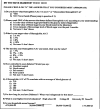Knowledge of Hemoglobin A1c and Glycemic Control in an Urban Population
- PMID: 33880312
- PMCID: PMC8053309
- DOI: 10.7759/cureus.13995
Knowledge of Hemoglobin A1c and Glycemic Control in an Urban Population
Abstract
Aim: Our study aims to assess the knowledge of hemoglobin A1c (HbA1c) and glycemic control in patients with diabetes mellitus (DM) at an urban academic institution.
Methods: This was a retrospective cross-sectional study that included a survey of 100 adult patients with DM. Our patient cohort was divided into those with recent HbA1c < 8.0% and those with HbA1c ≥ 8.0% for subgroup analysis.
Results: The majority (71%) of patients correctly defined HbA1c and half were aware of their HbA1c target, but they were unable to correlate the correct average blood glucose for an HbA1c level of 7%. Worse control, defined as an HbA1c level of ≥ 8%, was associated with co-morbid disease, but was not associated with understanding HbA1c definition, target or socioeconomic disparities. Perceived glycemic control was congruent with the actual control in 46% of our patients. Ninety percent of those with HbA1c ≥ 8% perceived their control to be better than it actually was, and 97% of those with HbA1c < 8% perceived their control worse than it actually was (P < 0.00001).
Conclusion: Although most patients knew the definition of HbA1c, they were unable to correlate HbA1c with average blood sugar. There remain opportunities to increase education for this vulnerable population with co-morbid disease on the use of the HbA1c disease marker as an education tool.
Keywords: diabetes; glycemic control; hba1c; hemoglobin a1c; patient perception.
Copyright © 2021, Memon et al.
Conflict of interest statement
The authors have declared that no competing interests exist.
References
-
- Patients with lower activation associated with higher costs; delivery systems should know their patients' 'scores'. Hibbard JH, Greene J, Overton V. Health Aff (Millwood) 2013;32:216–222. - PubMed
-
- American Diabetes Association. Standards of Medical Care in Diabetes - 2019. Vol. 42. American Diabetes Association; 2019. Standards of Medical Care in Diabetes; p. 0.
LinkOut - more resources
Full Text Sources
Other Literature Sources

